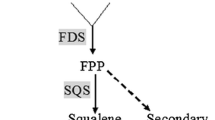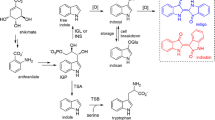Abstract
The Physcomitrella patens genome has seven genes apparently coding for the isopentenyltransferase type of tRNA-modifying enzyme, while other organisms have one or two. The predicted sequences have parts that differ significantly from other isopentenyltransferases. Only one of the seven (PpIPT1) has earlier been shown to be expressed. We now report expression of two more, PpIPT4 and PpIPT5. The cloned genes were able to functionally complement a yeast mutant lacking tRNA isopentenyltransferase. Sequencing showed they are related to the earlier studied PpIPT1. The sequences of the three differ mainly from each other in a tRNA-binding area and the 5′-end subcellular targeting motif area. This indicates that, after arising through gene duplication, they have evolved to enable partly different functions.





Similar content being viewed by others
Abbreviations
- IPT:
-
Isopentenyltransferase
- tRNA-IPT:
-
tRNA isopentenyltransferase
- ATP/ADP-IPT:
-
Adenylate isopentenyltransferase
- PpIPT:
-
Physcomitrella patens isopentenyltransferase
- i6A:
-
N 6-(Δ2-isopentenyl)adenosine, isopentenyladenosine
References
Bruce BD (2001) The paradox of plastid transit peptides: conservation of function despite divergence in primary structure. Biochim Biophys Acta 1541:2–21
Buck M, Connick M, Ames BN (1983) Complete analysis of tRNA-modified nucleosides by high-performance liquid chromatography: the 29 modified nucleosides of Salmonella typhimurium and Escherichia coli tRNA. Anal Biochem 129:1–13
Chu H-M, Ko TP, Wang AH-J (2010) Crystal structure and substrate specificity of plant adenylate isopentenyltransferase from Humulus lupulus: distinctive binding affinity for purine and pyrimidine nucleotides. Nucl Acids Res 38:1738–1748
Cove D, Bezanilla M, Harries P, Quatrano R (2006) Mosses as model systems for the study of metabolism and development. Ann Rev Plant Biol 57:497–520
Edgar RC (2004) Muscle: multiple sequence alignment with high accuracy and high throughput. Nucl Acids Res 32:1792–1797
Emanuelsson O, Nielsen H, Brunak S, von Heijne G (2000) Predicting subcellular localization of proteins based on their N-terminal amino acid sequence. J Mol Biol 300:1005–1016
Engel P (1968) The induction of biochemical and morphological mutants in the moss, Physeomitrella patens. Am J Bot 55:438–446
Filichkin SA, Priest HD, Givan SA, Shen R, Bryant DW, Fox SE, Wong W, Mockler TC (2010) Genome-wide mapping of alternative splicing in Arabidopsis thaliana. Genome Res 20:45–58
Galante PAF (2004) Detection and evaluation of intron retention events in the human transcriptome. RNA 10:757–765
Gehrke CW, Kuo KC, McCune RA, Gerhardt KO (1982) Quantitative enzymatic hydrolysis of tRNAs: reversed-phase high-performance liquid chromatography of tRNA nucleosides. J Chrom 230:297–308
Gietz RD, Schiestl RH (1997) Transforming yeast with DNA. Mol Cell Biol 5:255–269
Gillman EC, Slusher LB, Martin NC, Hopper AK (1991) MOD5 translation initiation sites determine N6- isopentenyladenosine modification of mitochondrial and cytoplasmic tRNA. Mol Cell Biol 11:2382–2390
Golovko A, Hjälm G, Sitbon F, Nicander B (2000) Cloning of a human tRNA isopentenyl transferase. Gene 258:85–93
Golovko A, Sitbon F, Tillberg E, Nicander B (2002) Identification of a tRNA isopentenyltransferase gene from Arabidopsis thaliana. Plant Mol Biol 49:161–169
Grimsley NH, Ashton NW, Cove DJ (1977) Complementation analysis of auxotrophic mutants of the moss, Physcomitrella patens, using protoplast fusion. Mol Gen Genet 155:103–107
Gu R, Fu J, Guo S, Duan F, Wang Z, Mi G, Yuan L (2010) Comparative expression and phylogenetic analysis of maize cytokinin dehydrogenase/oxidase (CKX) gene family. J Plant Growth Regul 29:428–440
Hennikoff S, Hennikoff JG (1992) Amino acid substitution matrices from protein blocks. Proc Natl Acad Sci USA 89:10915–10919
Hohe A, Rensing SA, Mildner M, Lang D, Reski R (2002) Day length and temperature strongly influence sexual reproduction and expression of a novel MADS-box gene in the moss Physcomitrella patens. Plant Biol 4:595–602
Hopper AK, Banks FEV (1978) A yeast mutant which accumulates precursor tRNAs. Cell 14:211–219
Lang D, Zimmer AD, Rensing SA, Reski R (2008) Exploring plant biodiversity: the Physcomitrella genome and beyond. Trends Plant Sci 13:542–549
Laten HM, Zahareas-Doktor S (1985) Presence and source of free isopentenyladenosine in yeasts. Proc Natl Acad Sci USA 82:1113–1115
Letham DS, Palni LMS (1983) The biosynthesis and metabolism of cytokinins. Ann Rev Plant Physiol 34:163–197
Leung HE, Chen Y, Winkler ME (1997) Regulation of substrate recognition by the MiaA tRNA prenyltransferase modification enzyme of Escherichia coli K-12 * properties as native MiaA and was completely active for. J Biol Chem 272:13073–13083
Martin A, Lang D, Hanke ST, Mueller SJX, Sarnighausen E, Vervliet-Scheebaum M, Reski R (2009) Targeted gene knockouts reveal overlapping functions of the five Physcomitrella patens FtsZ isoforms in chloroplast division, chloroplast shaping, cell patterning, plant development, and gravity sensing. Mol Plant 2:1359–1372
Miyawaki K, Matsumoto-Kitano M, Kakimoto T (2004) Expression of cytokinin biosynthetic isopentenyltransferase genes in Arabidopsis : tissue specificity and regulation by auxin, cytokinin, and nitrate. Plant J 37:128–138
Miyawaki K, Tarkowski P, Matsumoto-Kitano M, Kato T, Sato S, Tarkowska D, Tabata S, Sandberg G, Kakimoto T (2006) Roles of Arabidopsis ATP/ADP isopentenyltransferases and tRNA isopentenyltransferases in cytokinin biosynthesis. Proc Natl Acad Sci USA 103:16598–16603
Persson BC, Esberg B, Olafsson O, Björk GR (1994) Synthesis and function of isopentenyl adenosine derivatives in tRNA. Biochimie 76:1152–1160
Pils B, Heyl A (2009) Unravelling the evolution of cytokinin signalling. Plant Physiol 151:782–791
Proost S, van Bel M, Sterck L, Billiau K, van Parys T, van de Peer Y, Vandepoele K (2009) Plaza: a comparative genomics resource to study gene and genome evolution in plants. Plant Cell 21:3718–3731
Reddy ASN (2007) Alternative splicing of pre-messenger RNAs in plants in the genomic era. Ann Rev Plant Biol 58:267–294
Rensing SA, Fritzowsky D, Lang D, Reski R (2005) Protein encoding genes in an ancient plant: analysis of codon usage, retained genes and splice sites in a moss, Physcomitrella patens. BMC Genomics 6:43
Rensing SA, Ick J, Fawcett JA, Lang D, Zimmer A, van de Peer Y, Reski R (2007) An ancient genome duplication contributed to the abundance of metabolic genes in the moss Physcomitrella patens. BMC Evol Biol 7:130
Rensing SA, Lang D, Zimmer AD, Terry A, Salamov A, Shapiro H, Nishiyama T, Perroud P-F, Lindquist EA, Kamisugi Y, Tanahashi T, Sakakibara K, Fujita T, Oishi K, Shin-I T, Kuroki Y, Toyoda A, Suzuki Y, Hashimoto S-I, Yamaguchi K, Sugano S, Kohara Y, Fujiyama A, Anterola A, Aoki S, Ashton N, Barbazuk WB, Barker E, Bennetzen JL, Blankenship R et al (2008) The Physcomitrella genome reveals evolutionary insights into the conquest of land by plants. Science 319:64–69
Reutter K, Atzorn R, Hadeler B, Schmülling T, Reski R (2008) Expression of the bacterial ipt gene in Physcomitrella rescues mutations in budding and in plastid division. Planta 206:196–203
Sakakibara H (2006) Cytokinins: activity, biosynthesis, and translocation. Ann Rev Plant Biol 57:431–449
Sakakibara K, Nishiyama T, Deguchi H, Hasebe M (2008) Class 1 KNOX genes are not involved in shoot development in the moss Physcomitrella patens but do function in sporophyte development. Evol Dev 10:555–566
Seif E, Hallberg BM (2009) RNA-protein mutually induced fit: structure of Escherichia coli isopentenyl-tRNA transferase in complex with tRNA(Phe). J Biol Chem 284:6600–6604
Slusher LB, Gillman EC, Martin NC, Hopper AK (1991) mRNA leader length and initiation codon context determine alternative AUG selection for the yeast gene MOD5. Proc Natl Acad Sci USA 88:9789–9793
Spinola M, Galvan A, Pignatiello C, Conti B, Pastorino U, Paroni R, Dragani TA (2005) Identification and functional characterization of the candidate tumor suppressor gene TRIT1 in human lung cancer. Oncogene 24:5502–5509
Thelander M, Olsson T, Ronne H (2004) Snf1-related protein kinase 1 is needed for growth in a normal day-night light cycle. EMBO J 23:1900–1910
Tsang TH, Buck M, Ames B (1983) Sequence specificity of tRNA-modifying enzymes an analysis of 258 tRNA sequences. Biochim Biophys Acta 741:180–196
Waterhouse AM, Procter JB, Martin DMA, Clamp M, Barton GJ (2009) Jalview version 2–a multiple sequence alignment editor and analysis workbench. Bioinformatics 25:1189–1191
Wise HZ, Saxena IM, Brown RM (2010) Isolation and characterization of the cellulose synthase genes PpCesA6 and PpCesA7 in Physcomitrella patens. Cellulose 18:371–384
Yevdakova NA, von Schwartzenberg K (2007) Characterisation of a prokaryote-type tRNA-isopentenyltransferase gene from the moss Physcomitrella patens. Planta 226:683–695
Yevdakova NA, Motyka V, Malbeck J, Trávníčková A, Novák O, Strnad M, von Schwartzenberg K (2008) Evidence for importance of tRNA-dependent cytokinin biosynthetic pathway in the moss Physcomitrella patens. J Plant Growth Regul 27:271–281
Zhou C, Huang RH (2008) Crystallographic snapshots of eukaryotic dimethylallyltransferase acting on tRNA: insight into tRNA recognition and reaction mechanism. Proc Natl Acad Sci USA 105:16142–16147
Acknowledgments
We thank Mattias Thelander for teaching the culturing of moss, and Hans Ronne for the Uppsala K-1 strain. Anita K. Hopper is thanked for the yeast lines. Grzegorz Furman is thanked for contributing to setting up the tRNA nucleoside analysis.
Author information
Authors and Affiliations
Corresponding author
Rights and permissions
About this article
Cite this article
Patil, G., Nicander, B. Identification of two additional members of the tRNA isopentenyltransferase family in Physcomitrella patens . Plant Mol Biol 82, 417–426 (2013). https://doi.org/10.1007/s11103-013-0072-x
Received:
Accepted:
Published:
Issue Date:
DOI: https://doi.org/10.1007/s11103-013-0072-x




